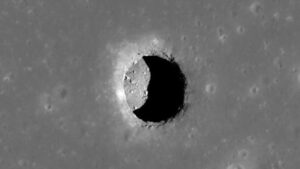The sun images released by NASA last week appeared cute and friendly to some who saw the space agency’s initial Twitter post.
To others, it looks like something out of Sam Raimi’s nightmares.
And according to scientists, the dark holes that human beings immediately anthropomorphized actually represent a potential threat to humanity.
In NASA’s image, the sun has three dark patches that form the “face.” Those black spots aren’t visible to the naked eye because they’re in the ultraviolet spectrum. Scientists refer to these patches as coronal holes. They represent slightly less-hot sections of the star’s outer layer, which usually burns at a brisk 5,500˚C.
But there’s a real danger behind this smiling sun. High magnetic-field activity characterizes the coronal holes, which means they throw solar winds into space, according to Brian Keating, a physics professor at the University of California at San Diego.
“More so than a smiley face, its eyes are like gleaming laser beams sending particles that can cause severe disruptions to the atmosphere on Earth,” Keating told The Washington Post.
Say cheese! 📸
Today, NASA’s Solar Dynamics Observatory caught the Sun “smiling.” Seen in ultraviolet light, these dark patches on the Sun are known as coronal holes and are regions where fast solar wind gushes out into space. pic.twitter.com/hVRXaN7Z31
— NASA Sun, Space & Scream 🎃 (@NASASun) October 26, 2022
A worst-case scenario
The Earth is long overdue for a fiery reminder of the sun’s power, Keating said.
When the small particles loosed into space by those coronal holes hit Earth, they can cause problems. The ones not sucked into the planet’s magnetic field can get picked up by radio antennae, disrupting communications. A severe solar storm could damage electrical grids and cause power outages.
And unfortunately, it’s not a problem that NASA can fix with a solution like crashing a probe into it.
The last geomagnetic storm to hit Earth came during the 1859 Carrington Event, a “super storm” that started fires at several telegraph stations. Since then, things have stayed pretty calm, and now the planet is overdue for another one, Keating said.
“Scientists expect that to happen on average, with a couple of percent probability, every year, and we’ve just dodged all these magnetic bullets for so long,” Keating said. “So it could be really scary, and the consequences could be much more dramatic, especially in our technology-dependent current society.”
That’s why the National Oceanic and Atmospheric Administration (NOAA)’s Space Weather Prediction Center issued a minor geomagnetic storm watch Saturday. For all of us here on terra firma, the NOAA predicts “weak fluctuations” in power grids. It listed the area of impact as “primarily” poleward.
The agency warns that solar particles from the coronal holes could continue through Wednesday.






